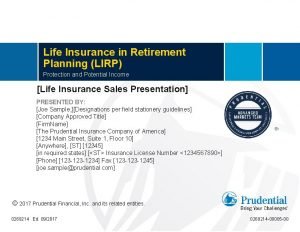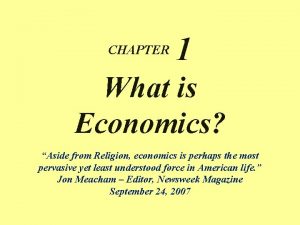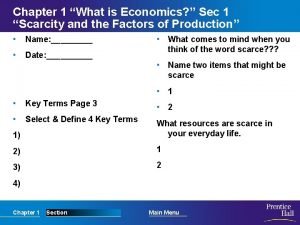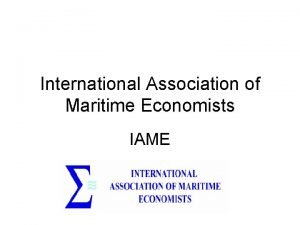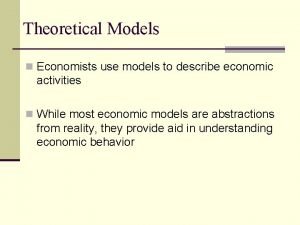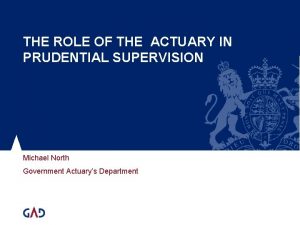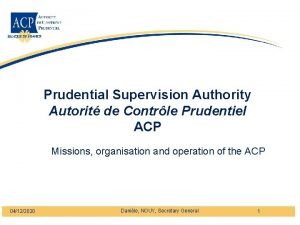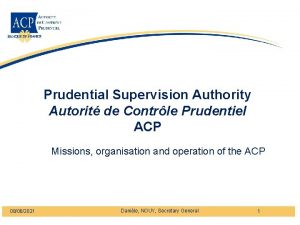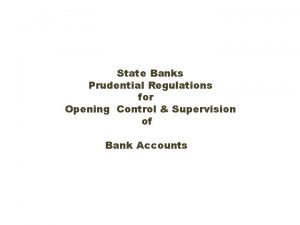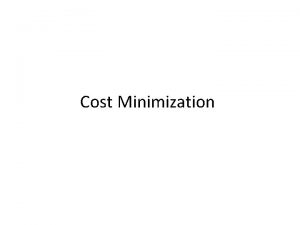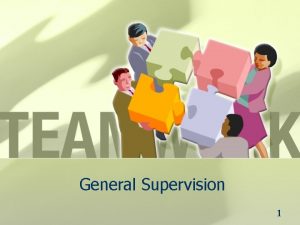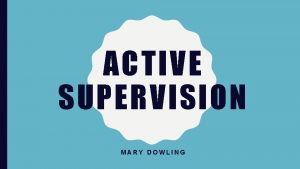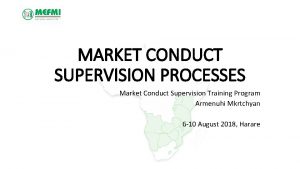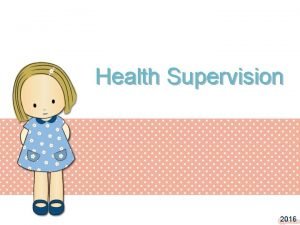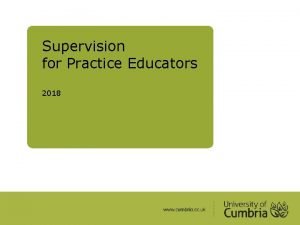The Role of Economists In Prudential Supervision of












































- Slides: 44

The Role of Economists In Prudential Supervision of Banks Fourth Quarter 2008 Richard A. Brown Chief Economist, FDIC September 21, 2009

What is Prudential Supervision of Banks? “Prudential supervision, broadly construed, involves government regulation and monitoring of the banking system to ensure its safety and soundness. ” Mishkin (2001)

Why Supervise Banks? • Banks are special – Banks issue transactions accounts that are regarded as perfectly safe and perfectly liquid – Banks are critical sources of backup liquidity – Collectively, banks make up the payments system and facilitate end-ofday settlement



Why Supervise Banks? • Banks are fragile – Banks are subject to liquidity runs – Banks are interconnected through payments system, leading to systemic risk – Banks tend to be subject to other types of correlated risks


Dealing with Fragility • Crisis Tools

Dealing with Fragility • Crisis Tools – Lender of Last Resort


Federal Reserve Liquidity Programs • Term Auction Facility (TAF) - December 2007 • Reciprocal Currency Agreements – December 2007 • Term Securities Lending Facility (TSLF) - March 2008 • Primary Dealer Credit Facility (PDCF) – March 2008 • Asset Backed CP Money Mkt Fund Liquidity Facility (AMLF) – Sept 2008 • The Commercial Paper Funding Facility (CPFF) – October 2008 • The Money Market Investor Funding Facility (MMIFF) – October 2008 • Term Asset-Backed Securities Loan Facility (TALF) – November 2008 • Mortgage Backed Securities Program (MBS) – November 2008

Dealing with Fragility • Crisis Tools – Lender of Last Resort – Deposit Insurance

FDIC Temporary Liquidity Guarantee Program • Authorized by FDIC Board in October 2008 under systemic risk finding, extended in 2009 • Two components: 1. Guarantee of senior unsecured debt issued by insured depository institutions and most depository institution holding companies 2. Guarantee of noninterest bearing transaction deposit accounts in excess of deposit insurance limits. • Participation: – Debt guarantee program – about half of eligible companies opted in – Transaction account guarantee program -- 7, 101 banks and thrifts • Fees: – Debt guarantee program – 50 to 100 basis points depending on maturity – Transactions accounts – 10 basis points, rising to 15, 20 or 25 in 2010. • $301. 5 billion in FDIC-guaranteed debt outstanding as of Sept. 16

Dealing with Fragility • Crisis Tools – Lender of Last Resort – Deposit Insurance – Extraordinary Support -- TARP

Troubled Assets Relief Program (TARP) • $700 billion total authorized funding, in two tranches • Authorizes Treasury to “purchase or insure” troubled assets • MBS and whole loan purchase programs – shelved for now • As of September 2009, about $364 billion has been distributed through five programs: – Capital Purchase Program • $204. 5 billion distributed to 671 depository institutions and bank holding companies – Systemically Significant Failing Institution Program • $40 preferred equity stake in AIG, plus $3. 2 billion drawn on credit line – Targeted Investment Program • $20 billion preferred equity stake each in Citigroup and Bank of America – Asset Guarantee Program • $12. 5 billion in loan guarantees for Citigroup and Bank of America – Automotive Industry Financing Program • $76 billion was used to assist the automotive industry

Dealing with Fragility • Crisis Tools – Lender of Last Resort – Deposit Insurance – Extraordinary Support – TARP • Prudential Management of the Deposit Insurance Fund (DIF)

Prudential Management of the Deposit Insurance Fund (DIF) • Reserve adequacy of DIF – Target reserve ratio: 1. 25% of insured deposits – Restoration plan required if below 1. 15% – Currently at 0. 22% • Risk-Based Deposit Insurance Premiums – Currently 12 -16 basis points for lowest risk categories – Up to 50 basis points for highest risk category • Prompt Corrective Action (PCA) – Institutions must be closed at 2% tangible capital • Least Cost Test for Failure Resolution – Systemic Risk Exception

Dealing with Fragility • Crisis Tools – Lender of Last Resort – Deposit Insurance – Extraordinary Support – TARP • Prudential Management of the Deposit Insurance Fund (DIF) • Prudential Supervision

Core Tools of Prudential Supervision • Asset Restrictions • Capital Requirements • Restrictions on Competition • Consumer Protection • On-site (and off-site) examination • Moral Suasion





Mortgage credit distress began in subprime portfolios, but now extends to prime portfolios as well. Source: Mortgage Bankers Association, National Delinquency Survey.






Core Tools of Prudential Supervision • Asset Restrictions • Capital Requirements • Restrictions on Competition • Consumer Protection • On-site (and off-site) examination • Moral Suasion

Core Tools of Prudential Supervision • Asset Restrictions • Capital Requirements • Restrictions on Competition • Consumer Protection • On-site (and off-site) examination • Moral Suasion

Core Tools of Prudential Supervision • Asset Restrictions • Capital Requirements • Restrictions on Competition • Consumer Protection • On-site (and off-site) examination • Moral Suasion

Core Tools of Prudential Supervision • Asset Restrictions • Capital Requirements • Restrictions on Competition • Consumer Protection • On-site (and off-site) examination • Moral Suasion



Core Tools of Prudential Supervision • Asset Restrictions • Capital Requirements • Restrictions on Competition • Consumer Protection • On-site (and off-site) examination • Moral Suasion

Limits of Moral Suasion in Promoting Safe and Sound Financial Practices “In 1929, a robust denunciation of speculators and speculation by someone in high authority and a warning that the market was too high would almost certainly have broken the spell. It would have brought some people back from the world of make-believe. . . The very effectiveness of such a measure was the problem. Of all the weapons in the Federal Reserve arsenal, words were the most unpredictable in their consequences. Their effect might be sudden and terrible. Moreover, these consequences could be attributed with the greatest precision to the person or persons who uttered the words. Retribution would follow. To the more cautious of the Federal Reserve officials in the early part of 1929, silence seemed literally golden. ” John Kenneth Galbraith, The Great Crash: 1929 (1955), p. 59.


What Was the FDIC Saying About the Risks in Housing Markets and Mortgage Lending? “The broadening of the U. S. housing boom during 2004 may imply a growing role for national factors– including the availability, price, and terms of mortgage credit–in explaining home price trends. To the extent that credit conditions are in fact driving home price trends, the implication would be that a reversal in mortgage market conditions could contribute to an end of the housing boom. ” Angell and Williams, “U. S. Home Prices: Does Bust Always Follow Boom? ” FDIC: FYI, February 10, 2005.

What Was the FDIC Saying About the Risks in Housing Markets and Mortgage Lending? “In addition, as our previous FYI report discussed, there have been a number of changes in mortgage markets that could have an influence on home prices, including the emergence of high loan -to-value lending and subprime lending. ” “Another evolving trend that has not been tested in a housing market downturn is the increasing market penetration of innovative mortgage products, such as interest-only (I/O) and option ARMs…While financially savvy borrowers using these products are more likely to be prepared for the possibility that their monthly payments may jump sharply, marginal borrowers may face greater difficulties adjusting as their monthly payments inevitably rise. ” Angell and Williams, “FYI Revisited -- U. S. Home Prices: Does Bust Always Follow Boom? ” FDIC: FYI, May 2, 2005.


New Challenges in Prudential Supervision • Financial Innovation • Incentive Structures • Jurisdictional Gaps • Macro-Prudential Supervision

Macro Prudential Supervision “A bubble can easily be punctured. But to incise it with a needle so that it subsides gradually is a task of no small delicacy. Among those who sensed what was happening in early, 1929, there was some hope but no confidence that the boom could be made to subside. The real choice was between an immediate and deliberately engineered collapse and a more serious disaster later on. Someone would certainly be blamed for the ultimate collapse when it came. There was no question whatever as to who would be blamed should the boom be deliberately deflated. ” John Kenneth Galbraith, The Great Crash: 1929 (1955), p. 52.

Questions
 Prudential
Prudential Prudential lirp
Prudential lirp Icici pru pinnacle super lp fund value
Icici pru pinnacle super lp fund value Icici elite wealth
Icici elite wealth Prudential retirement app
Prudential retirement app Econ
Econ To help unscramble cause and effect, economists
To help unscramble cause and effect, economists Chapter 1 section 1 scarcity
Chapter 1 section 1 scarcity International association of maritime economists
International association of maritime economists Economists use models to
Economists use models to Economists group industries into distinct market structures
Economists group industries into distinct market structures Role conflict occurs when fulfilling the role expectations
Role conflict occurs when fulfilling the role expectations Azure web role worker role example
Azure web role worker role example Symbolischer interaktionismus krappmann
Symbolischer interaktionismus krappmann Tỉ lệ cơ thể trẻ em
Tỉ lệ cơ thể trẻ em Thế nào là mạng điện lắp đặt kiểu nổi
Thế nào là mạng điện lắp đặt kiểu nổi Lời thề hippocrates
Lời thề hippocrates Vẽ hình chiếu đứng bằng cạnh của vật thể
Vẽ hình chiếu đứng bằng cạnh của vật thể Quá trình desamine hóa có thể tạo ra
Quá trình desamine hóa có thể tạo ra Phản ứng thế ankan
Phản ứng thế ankan Các môn thể thao bắt đầu bằng từ đua
Các môn thể thao bắt đầu bằng từ đua Sự nuôi và dạy con của hươu
Sự nuôi và dạy con của hươu Các loại đột biến cấu trúc nhiễm sắc thể
Các loại đột biến cấu trúc nhiễm sắc thể điện thế nghỉ
điện thế nghỉ Thế nào là sự mỏi cơ
Thế nào là sự mỏi cơ Trời xanh đây là của chúng ta thể thơ
Trời xanh đây là của chúng ta thể thơ Gấu đi như thế nào
Gấu đi như thế nào Thiếu nhi thế giới liên hoan
Thiếu nhi thế giới liên hoan Vẽ hình chiếu vuông góc của vật thể sau
Vẽ hình chiếu vuông góc của vật thể sau Một số thể thơ truyền thống
Một số thể thơ truyền thống Các châu lục và đại dương trên thế giới
Các châu lục và đại dương trên thế giới Thế nào là hệ số cao nhất
Thế nào là hệ số cao nhất Sơ đồ cơ thể người
Sơ đồ cơ thể người Số nguyên tố là gì
Số nguyên tố là gì Tư thế ngồi viết
Tư thế ngồi viết Hát kết hợp bộ gõ cơ thể
Hát kết hợp bộ gõ cơ thể đặc điểm cơ thể của người tối cổ
đặc điểm cơ thể của người tối cổ Mật thư anh em như thể tay chân
Mật thư anh em như thể tay chân Glasgow thang điểm
Glasgow thang điểm ưu thế lai là gì
ưu thế lai là gì Thẻ vin
Thẻ vin Cái miệng xinh xinh thế chỉ nói điều hay thôi
Cái miệng xinh xinh thế chỉ nói điều hay thôi Các châu lục và đại dương trên thế giới
Các châu lục và đại dương trên thế giới Bổ thể
Bổ thể

